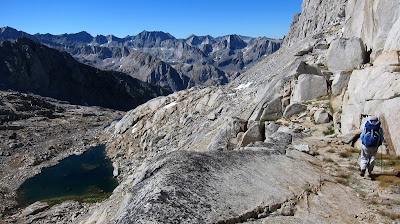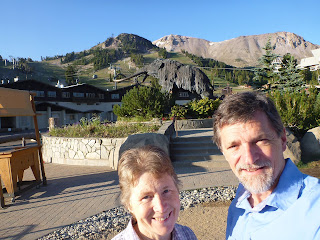 This day we crossed Pinchot Pass
This day we crossed Pinchot Pass(pictured above, and from where we are looking north) (3693m/12120ft), and then commenced a very long descent, which didn't stop til the next day. Whilst we were tempted to drop down to the Twin Lakes below Mt Cedric Wright, we found a spot next to a pretty lake close to the trail (pictured left, looking south towards Mt Clarence King - which we'd get pretty close to, around its back, by the end of the next day). But the water was starting to dry off such that there was very little running water to speak of.
Day 24 was to a long stretch as we spent 11 hours from campsite to campsite, travelling nearly 19km/12mi (and dropping and climbing over 1200m/3940ft each direction) from above Twin Lakes to Sixty Lake Basin, east of Rae Lakes. The (700m/2300ft) descent down Woods Creek continued until late morning, followed by the inevitable ascent having crossed the creek to follow a different watercourse back up to maintain our southward trajectory. This took us past Dollar Lake, yet another Arrowhead Lake and the spectacular Rae Lakes, dominated as they were by Fin Dome. These four lakes all had a slight green tinge, quite possibly due to higher nutrient content from humans. The Rae Lake campsites looked a little love-worn, so we continued west to Sixty Lake Basin, which meant climbing another small (200m/650ft) pass late in the day.
The Basin (above at dawn the following day) was well worth the effort though, with a much more unsullied feel to it, as we camped right around on the opposite side of Fin Dome (on the right of the picture).
Day 25 we crossed back into the Rae Lakes basin and then continued up to Glen Pass for an early lunch before dropping yet again, this time towards Vidette Meadow, ultimately 700m/2300ft below. The southern passes however were all much easier to negotiate than the Sierra High Route passes, on account of the switchbacks engineered in all the tracks. We traversed high above Charlotte Lake (left) before dropping to traverse the crossroads going east to Kearsage Pass, north from whence we came, west to Charlotte Lake, and south to Bubbs Creek and Vidette Meadow. This patch was as hot, dry and desolate as any we had come across so far. Waiting for a food drop there must feel like waiting for Lucifer himself. Vidette Meadow was spacious and treed, but the amount of windfall logs made one a little nervous, especially when a brief thunderstorm blew through.
Day 26 started with an 1100m/3609ft 1:10 gradient climb (right) to Forester Pass (4006m/13143ft). As we ascended, we could hear more ominous rumbles from over the pass, and by the time we crested it at noon, it had started to lightly snow. Quickly donning warm and waterproof clothing (as best as our ultra-light preparations had allowed) we marched/hared down one of the more precarious switchbacks on the JMT/PCT, to get into the shelter of the forest. Not stopping for lunch for fear of getting too cold, we made camp by mid-afternoon, set up our tent, cooked up a hot soupy lunch and enjoyed being in our tent for most of the rest of the day. The cold blast had blown over, and we had reached warmer climes.
Chatting with a friendly neighbour - Michael - back at Barrett Lakes, we were inspired to visit the lakes on the Upper Kern Loop Trail, which loops west off the JMT north of Tyndall Creek campsite. So with a day up our sleeves, we took the time to head to the Upper Kern river, and then take the circuit clockwise to Lake South America, and come back to camp over the little pass (from which we could see Mt Whitney). It took us about 7 hours over 13km/8mi, and involved over 900m/2950ft climbing and the same descending back to camp. But it was sure pretty!
Day 28 we pushed on over the sparse and pretty Bighorn Plateau and increasingly sparser and sandier terrain to Crabtree and up to Guitar Lake, nestled below Mt Whitney. We got to Crabtree by lunch time and had hoped to get the scoop from the local ranger on whether we could camp up at Guitar Lake or not, but they were not to be found. Accepted wisdom is that if you're on the PCT, then you're allowed. There were "poop bags" for folks heading out over Whitney Portal, to try and reduce the amount of human waste on Mt Whitney. They're not really intended for hikers going in other directions, but we figured it had the same positive impact, so grabbed some and headed up. Guitar Lake is a very pretty place to stay, though pretty busy due to the whole Mt Whitney thing going on...
Day 29 was a doozy of a day. We got up about 4:45am to be on our way by 5:30am, heading up up up 960m/3150ft to the summit of Mt Whitney (4423m/14505ft, left, look for the shelter on the flat spot), the highest peak of the contiguous United States. Whilst we were getting ready, we could see scores of head-torches bobbing their way up the trail, which gave us a good idea of the route, it being illegible from below the afternoon before.
 It was a long, slow climb (3¼ hours) over yet another engineering feat as the route picked its way through a whole mountainside of talus (right). I'm not sure why there aren't more reports of altitude sickness for all the folks who climb up straight from Whitney Portal without any acclimatisation. We were certainly puffed! Below is the view south east from the summit, those lakes are about 900m/2950ft below, and Whitney Portal another 1100m/3600ft further down.
It was a long, slow climb (3¼ hours) over yet another engineering feat as the route picked its way through a whole mountainside of talus (right). I'm not sure why there aren't more reports of altitude sickness for all the folks who climb up straight from Whitney Portal without any acclimatisation. We were certainly puffed! Below is the view south east from the summit, those lakes are about 900m/2950ft below, and Whitney Portal another 1100m/3600ft further down.It took 2½ hours to descend back to Guitar Lake, where we had lunch, packed the tent and our now hot bear canisters, and continued down to Crabtree, and lower Crabtree Meadow, where in hindsight we should have stayed. However we pressed on, hoping to find a site by a stream, but there was no water for three hours, so we crossed Guyot Pass and continued to the oasis of Rock Creek. By the end of that day, we had hiked 21½km/13mi, climbed 1697m/5567ft, descended 2299m/7542ft, and been up and active for 13 hours! Phew! But what a magnificent day!
The huge effort of that day paid off the following day (30), as we had a shorter time of it hiking via the pretty Soldier Lakes to Army Pass and New Army Pass. We remember walking out of Rock Creek and thinking to ourselves "bacon!". Ten minutes later we passed the Ranger's Hut...
Our final pass, New Army Pass was - like many passes before - over 800m/2630ft above our breakfast spot. It revealed the Cottonwood Lakes spread below us, but 360m/1120ft below! Thankfully the switchbacks. so characteristic of this southern part of the Sierras, made the descent easy though a little tiresome.
And so our final day of our Sierra High Route/Mt Whitney hike, Day 31, dawned with the sun peeking over Long Lake. And like every other day, it got hot. By the end of the day, we had spent 31 days hiking up 27,796m/91,194ft (over three Mt Everests, from sea level) and down 27,665m/90,764ft. We spent 18 of those days attaining an elevation above 3,500m/11,482ft, and hiked 373km/232mi.
Disclaimer: The information given is of a general nature only and whilst all care has been taken, no responsibility can be assumed by the author.Conditions change, regulations change. Any reader doing these hikes after reading these notes must show due diligence and be experienced enough to take responsibility for their own decisions and actions.






















































